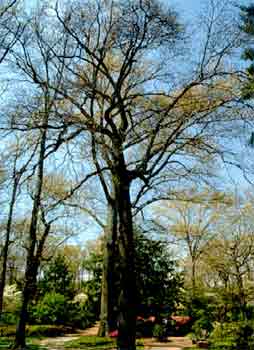 Pignut Hickory - Carya glabra
Pignut Hickory - Carya glabra
Walnut Family (Juglandaceae)
- Native habitat: Maine to Ontario, south to Mississippi, Alabama and Florida.
- Growth habit: This long-lived tree has a tapering trunk with an open, oval crown of slender branches.
- Tree size: A slow-growing tree that can attain a height of 50 to 60 feet and a 25- to 35-foot spread. It can grow to 100 feet tall in the wild.
- Flower and fruit: Male flowers are yellow-green catkins. Female flowers are in 2- to 5-flower spikes. Fruit is a bitter nut in a green husk.
 Leaf: An 8- to 12-inch-long compound leaf with five leaflets (shagbark hickory leaves have seven leaflets). The lowest two leaflets are one-third the size of the upper three leaflets. Dark yellowish-green foliage turns golden yellow in fall.
Leaf: An 8- to 12-inch-long compound leaf with five leaflets (shagbark hickory leaves have seven leaflets). The lowest two leaflets are one-third the size of the upper three leaflets. Dark yellowish-green foliage turns golden yellow in fall.- Hardiness: Winter hardy to USDA Zone 4.
The genus name, Carya, is from the Greek name for the walnut tree (karya); the species name, glabra, means glabrous or smooth, referring to the foliage. Although only a few hickory species exist outside of eastern North America (in eastern Asia), fossils indicate that hickories were once found in central Europe, China, the former Soviet Union, the western and southwestern U.S. and Alaska.
 Pignut hickory fruit has a small kernel with variable flavor, usually bitter and is fit to be eaten only by "pigs and other animals."
Pignut hickory fruit has a small kernel with variable flavor, usually bitter and is fit to be eaten only by "pigs and other animals."
The wood of hickory is famously heavy and tough yet flexible and shock-resistant. Because of these qualities, it is often used in sporting goods, such as skis, and for tool handles. Hickory wood also has low conductivity of heat. This characteristic made hickory the wood of choice for wagon wheels and sulkies for harness horses. It was used to make automobile parts in the early days of that industry. Pignut hickory is stronger than steel, yet more elastic, less brittle and less conductive of heat.
A 105-foot national champion pignut hickory is in Georgia. Pignut hickory was first cultivated in the U.S. in 1750.


